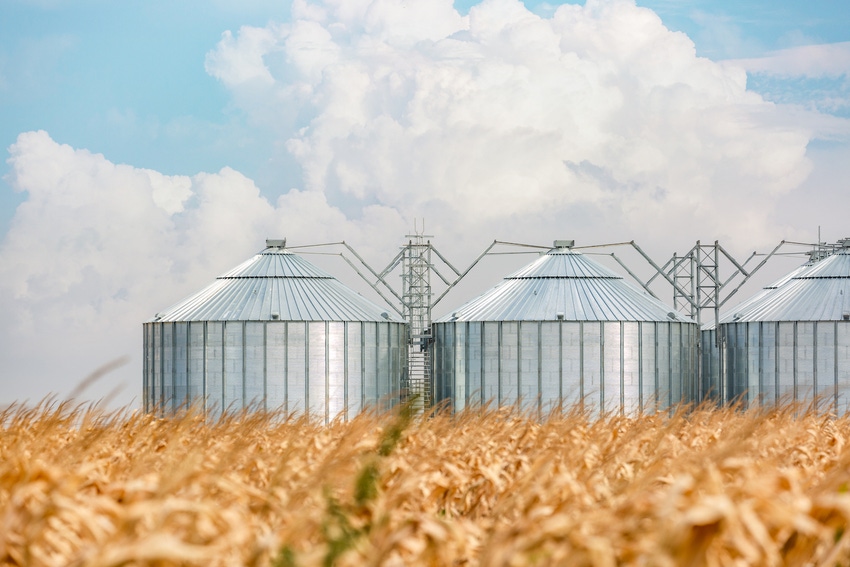
Commodity Credit Corporation commodity loans on harvested corn, soybeans and wheat were regularly used by farm operators in the 1990s and early 2000s as a grain marketing tool. The use of CCC loans dropped off considerably from 2008 to 2014, when grain prices reached their highest levels in many years. Now in recent years, the use of marketing assistance loans (MALs), which are the same as CCC commodity loans, has again taken on more significance as option to producers in setting up grain marketing plans for corn, soybeans and other crops.
The CCC commodity loans are originated through county Farm Service Agency offices after the grain has been harvested. The MALs are 9-month loans from the time the loan is established. A CCC commodity loan can be established both on farm-stored grain and on grain in commercial storage with a warehouse receipt. Producers receive the value of the loan at the time the CCC loan is established. The loan can be repaid at any time during the 9-month loan period, by repaying the amount of the loan principal plus the accrued interest.
The 2018 Farm Bill establishes national loan rates for the various commodities that are eligible for CCC MALs. Following are the 2020 national loan rates for common crops in the Upper Midwest:
Corn: $2.20 per bushel
Soybeans: $6.20 per bushel
Wheat: $3.38 per bushel
Barley: $2.50 per bushel
Oats: $2.00 per bushel
Grain sorghum: $2.20 per bushel
The county loan rates are then adjusted higher or lower than national rates, based on local commodity price differentials compared to national price levels. CCC loan rates for 2020 in Minnesota counties range from $2.01 to $2.13 per bushel for corn and $5.82 to $6.16 per bushel for soybeans. Iowa loan rates range from $2.06 to $2.29 per bushel for corn and $6.07 to $6.33 for soybeans. South Dakota loan rates range from $2.03 to $2.14 per bushel for corn and $5.67 to $6.09 per bushel for soybeans. North Dakota loan rates range from $1.98 to $2.18 per bushel for corn and $5.67 to $5.97 per bushel for soybeans. The CCC loan rates for all U.S. counties are available online.
The CCC loan interest rate is adjusted monthly and is set up at 1 percent above the CCC borrowing rate from the U.S. Treasury. The interest rate on CCC loans is fixed for the entire term of the 9-month MAL, except for a potential CCC interest rate adjustment on January 1. The current interest rate on CCC commodity loans is only 1.125 percent interest, which has been steady for several months. Producers only pay interest for the time that the MAL is in place. (Example: $100,000 MAL corn loan at 1.125% interest for 90 days ($100,000 x .0125) / 365 x 90 = $308.22 interest payment).
Farm operators have the flexibility to place grain under CCC loan at a local FSA office any time after the grain has been harvested. Producers also have the flexibility to treat the CCC commodity loan as either income or as a loan when the loan proceeds are received. This can have income tax implications, depending on how and when the loan proceeds are received. It is best consult with a tax consultant before determining the timing and the preferred method of receiving the loan proceeds
If commodity prices drop to levels that are lower than county loan rates, eligible producers would potentially be eligible to release the grain that is under a CCC commodity loan at a rate that is lower than the county loan rate. FSA issues a posted county price for commodities that are eligible for CCC loans, which are updated and posted daily at local FSA offices, or available on county FSA websites. If the PCP is lower than the county loan rate, the producer could realize a marketing loan gain, if the grain is released at that lower PCP. (Example: a producer places corn under a MAL at $2.10 per bushel, a few months later the PCP is $1.90 per bushel, resulting in the potential of a marketing loan gain of $.20 per bushel on the day the corn loan is released.)
If the PCP drops below the county CCC loan rate, producers also have the option to collect a loan deficiency payment (LDP) on a commodity, in lieu of putting the grain under CCC loan. The LDP calculation is similar to the calculation for marketing loan gains. Grain that is already under CCC loan is not eligible for a LDP, and a LDP can only be utilized once on the same bushels of grain. There has not been significant LDP eligibility for corn and soybeans since the early 2000s.
Producers must be eligible for USDA farm program benefits and must have submitted an acreage report at the FSA office for 2020 to be eligible for CCC commodity loans on this year’s crop production. Producers must maintain beneficial interest in the grain while it is under a CCC commodity loan. Beneficial interest means that the producer maintains control and title of the commodity while it is under a CCC loan. Producers should contact the FSA office to release any grain that is under a MAL with the CCC before it is delivered to market (call before you haul).
Following are some reasons that farm operators may want to consider utilizing CCC commodity loans (MALs) as part of their grain marketing strategies:
Provides short term credit at relatively low and stable interest rates.
Loan funds can be used to pay post-harvest expenses and land rental payments for the current year or for prepaid crop inputs (seed, fertilizer, etc.) for the following crop year.
Loan funds can also provide the necessary funds to make year-end or January principal and interest payments on term loans and real estate loans.
Allows a producer to receive partial compensation for corn and soybeans during or following the fall harvest season, when commodity prices are traditionally lower than average.
Allows a producer the flexibility to market the grain in future months after it been placed under a CCC loan, including forward pricing the grain for future delivery (the CCC loan must be satisfied at the FSA office before the grain is delivered).
CCC commodity loans can also be used by livestock producers that plan to feed the corn or other grain, which is followed by just releasing the grain that is under loan as it is fed.
If commodity prices decline below the county CCC loan rates, the grain that is under loan can be released at the lower price or producers can collect a loan deficiency payment (LDP).
For further information on marketing assistance loans (MALs) through the CCC and LDPs, farm operators should contact their local FSA office or go online.
About the Author(s)
You May Also Like






